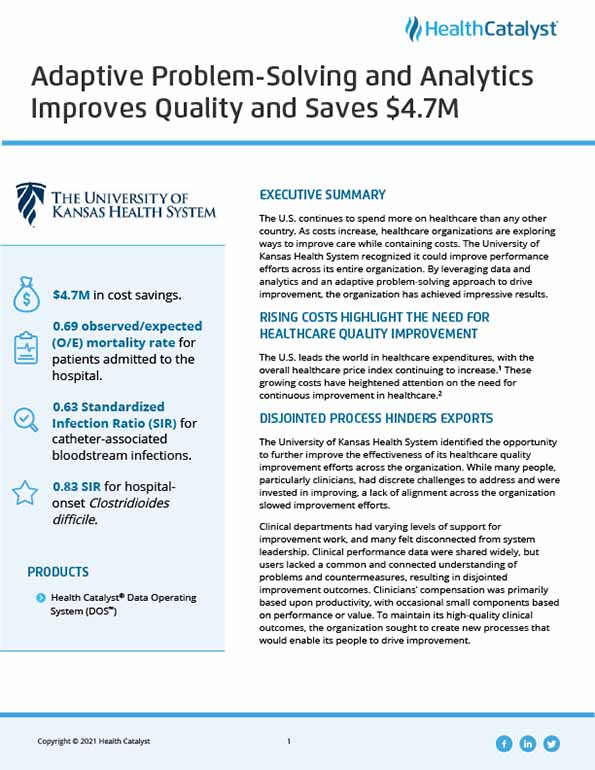The U.S. continues to spend more on healthcare than any other country. As costs increase, healthcare organizations are exploring ways to improve care while containing costs. The University of Kansas Health System recognized it could improve performance efforts across its entire organization. By leveraging data and analytics and an adaptive problem-solving approach to drive improvement, the organization has achieved impressive results.
The U.S. leads the world in healthcare expenditures, with the overall healthcare price index continuing to increase.1 These growing costs have heightened attention on the need for continuous improvement in healthcare.2
The University of Kansas Health System is a world-class academic medical center and destination for complex care and diagnosis. The organization’s culture of quality puts patients first and delivers the best care possible.
The University of Kansas Health System identified the opportunity to further improve the effectiveness of its healthcare quality improvement efforts across the organization. While many people, particularly clinicians, had discrete challenges to address and were invested in improving, a lack of alignment across the organization slowed improvement efforts.
Clinical departments had varying levels of support for improvement work, and many felt disconnected from system leadership. Clinical performance data were shared widely, but users lacked a common and connected understanding of problems and countermeasures, resulting in disjointed improvement outcomes. Clinicians’ compensation was primarily based upon productivity, with occasional small components based on performance or value. To maintain its high-quality clinical outcomes, the organization sought to create new processes that would enable its people to drive improvement.
The University of Kansas Health System embarked on developing and applying an adaptive approach to problem-solving and developing a strategic performance improvement system. The organization applies a problem-solving approach that ensures it identifies key stakeholders, involving them early and often. It defines success at the outset of problem-solving operations, leveraging data from the Health Catalyst® Data Operating System (DOS™) platform and a robust suite of analytics applications to understand, assist with, and evaluate improvement opportunities.
The organization uses constant Plan-Do-Check-Act improvement cycles to drive improvement. The business intelligence, applied analytics, and lean promotion office support and facilitate quality improvement procedures. The University of Kansas Health System links problems and possible solutions to the broader organizational vision and targets, leveraging its data and improvement resources to develop a clear and consistent understanding of the desired target performance from all stakeholders. Improvement work is aligned across the organization, and clinicians are actively engaged in improvement efforts.
The following four examples demonstrate how The University of Kansas Health System used its adaptive approach to problem-solving:
The Care Connections program emphasizes the core functions of an academic medical center and focuses on innovative approaches to performance improvement driven by physicians. The University of Kansas Health System provides foundational support for each Care Connections program, giving clinicians access to the data, measurement, and analytics resources required for success. The Care Connections program:
Department chairs and senior administrators partner with business intelligence, applied analytics, and the lean promotion office for planning sessions. The teams partner to understand departmental data, including definitions, timeliness, limitations, trends, and the stories behind the trends. Department finance and planning sessions drive alignment between clinicians and health system leadership, empowering them to use data to identify data-informed improvement strategies and tactics.
Leaders use the planning sessions to review detailed data and gain new insight into performance in four major areas: financials, operations/growth, workforce, and market. Leaders are then able to understand the demand from the market perspective, workforce supply, and the internal resources to accommodate that demand and comprehend the impact on the health system’s financial success. The planning sessions provide the opportunity to select performance measures that clinicians can successfully impact.
The University of Kansas Health System is chasing zero harm through an interdisciplinary team that facilitates patient safety improvement efforts across the organization. The organization leverages the analytics platform as the single source of truth for zero harm data, using process behavior charts to help identify signals in the data. It also uses data from the analytics platform to provide continuous monitoring, measurement, management, and prevention of all-cause harm events.
The University of Kansas Health System engages departments and divisions in moving away from compensation being based primarily on volume or productivity and toward being based on value. The organization’s value-based performance (VBP) improvement pilot projects find improvement opportunities that both the health system and physicians see as valuable. The organization implemented five VBP pilot projects focused on medication utilization and readmission reduction. It supports the physician department or division in idea generation, measurement selection, establishing baselines, and analytics required for improvement.
Through these VBP pilot projects, the organization strives to:
The University of Kansas Health System’s efforts to build a strategic performance improvement system is delivering the desired results. All 21 clinical departments have annual growth and improvement plans in place, and the organization has generated $4.7M in cost savings.
We’ve leveraged data from the analytics platform and standard tools and processes to engage clinicians and operational leaders in improvement. We’ve successfully enhanced the patient experience, improved population health, and reduced costs—saving more than $4M while improving the experience of our clinicians and staff.
- Jack Beal, JD, Vice President, Performance Improvement and Deputy General Counsel, The University of Kansas Health System
The University of Kansas Health System will continue to develop its strategic performance improvement system, maximizing the value of its data and engaging clinical and operational leaders to further improve outcomes.


